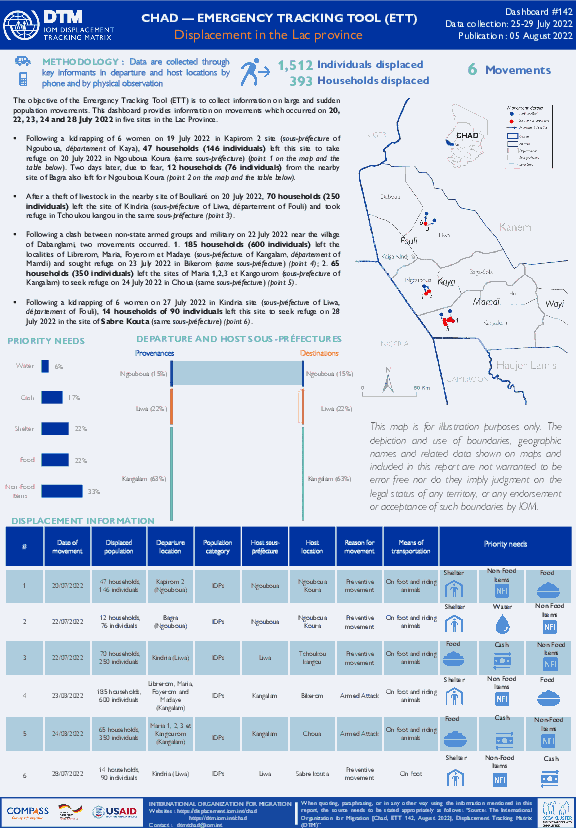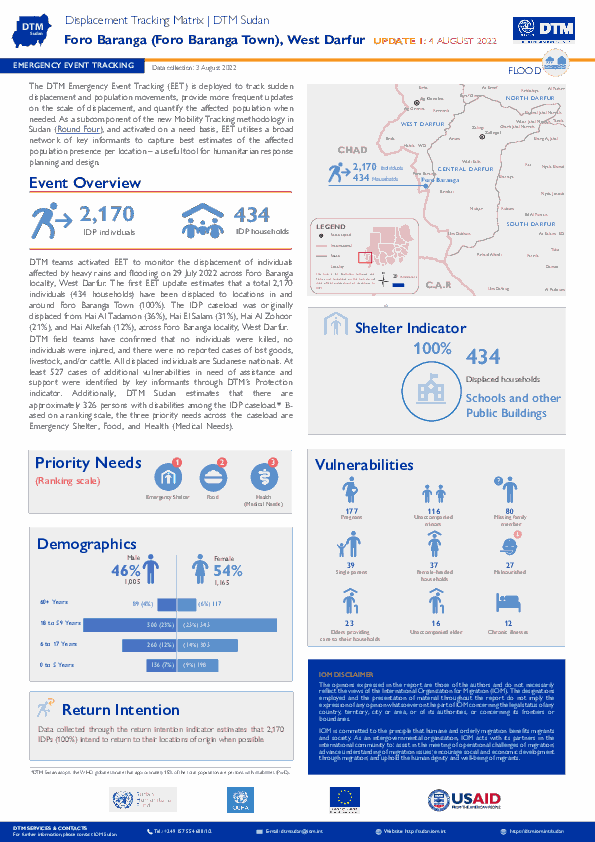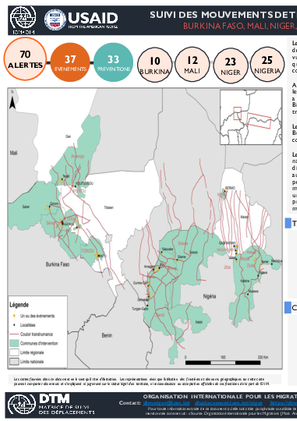-
Countries
-
Data and Analysis
-
Special Focus
-
Crisis Responses

Contact
DTM Chad, dtmtchad@iom.int
Language
English
Location
Chad
Period Covered
Jul 20 2022
Jul 28 2022
Activity
- Mobility Tracking
- Event Tracking
The objective of the Emergency Tracking Tool (ETT) is to collect information on large and sudden population movements. Data are collected through key informants in departure and host locations by phone and by physical observation. This dashboard provides information on 6 movements which occurred on 20, 22, 23, 24 and 28 July 2022 in five sites in the Lac Province.

Contact
DTM Guinée, oimguineedtm@iom.int
Language
French
Location
Guinea
Period Covered
Apr 01 2022
Jun 30 2022
Activity
- Survey
- Flow Monitoring Survey
- Flow Monitoring
Le suivi des flux, qui est mis en œuvre en étroite collaboration avec les autorités et des partenaires nationaux et locaux, est composé de deux outils : l’enregistrement des flux (Flow Monitoring Registry, FMR), qui recueille des données clés sur l’ampleur, la provenance, la destination et les modalités des flux, et les enquêtes individuelles (Flow Monitoring Survey, FMS), conduites auprès des voyageurs afin d’obtenir des informations sur les profils, les parcours migratoires et les intentions des migrants. Le suivi des flux de populations récolte ainsi des données clés sur les flux et les tendances migratoires, les profils des voyageurs, les parcours et intentions des migrants, afin de fournir une meilleure compréhension des mobilités en Afrique de l’Ouest et du Centre.
En Guinée, la DTM recueille des données au niveau de trois point de suivi des flux (Flow Monitoring Point, FMP) a savoir : le FMP de Boundoufourdou dans la préfecture de Koundara au Nord du pays, les FMPs de Kourémalé et de Nafadji tous situés dans la préfecture de Siguiri au Nord-Est de la Guinée, dans le but d’identifier les zones à forte mobilité transfrontalière et récolter des données sur les tendances de mobilité, les profiles et les parcours des voyageurs dans le pays.
Ce rapport présente les données collectées pendant le deuxième trimestre de l’année 2022 au niveau des différents FMP actifs en Guinée.
Contact
DTM Ethiopia, SLOAddisAbabaDTM@iom.int
Location
Ethiopia
Activity
- Mobility Tracking
- Site Assessment
- Village Assessment
Period Covered
Jan 10 2022 -Apr 09 2022
A village assessment survey (VAS) is a sub-component of mobility tracking. It collects data on returning IDPs, IDPs, returned migrants and host community members. VAS evaluates the absorption capacity of villages to receive returning IDPs with a focus on accessibility of services, livelihoods and reintegration.
Population Groups
Survey Methodology
Unit of Analysis Or Observation
Type of Survey or Assessment
Keywords
Geographical Scope
Administrative boundaries with available data
The current dataset covers the following administrative boundaries
Contact
DTM Ethiopia, SLOAddisAbabaDTM@iom.int
Location
Ethiopia
Activity
- Mobility Tracking
- Site Assessment
Period Covered
Mar 01 2022 -Apr 18 2022
A site assessment is a sub-component of mobility tracking. It aims to collect data on population presence, living conditions and needs in a particular displacement site or community.
Population Groups
Survey Methodology
Unit of Analysis Or Observation
Type of Survey or Assessment
Keywords
Geographical Scope
Administrative boundaries with available data
The current dataset covers the following administrative boundaries

Contact
DTM Ethiopia, SLOAddisAbabaDTM@iom.int
Language
English
Location
Ethiopia
Period Covered
Mar 01 2022
Apr 18 2022
Activity
- Mobility Tracking
- Site Assessment
- Village Assessment
In order to capture the displacement and return dynamics in Ethiopia, DTM Ethiopia's National Displacement Report combines findings from its Site Assessment (SA) in Section 1 and findings from the Village Assessment Survey (VAS) in Section 2. The Site Assessment tracks the number of internally displaced persons (IDPs), while the Village Assessment Survey tracks the number of IDPs who are returning or have returned to their communities.
As of April 2022, a total of 2.75 million IDPs have been identified in 2,158 accessible sites across 11 regions in Ethiopia. As a note, due to operational constraints, figures from Tigray region were not included in the total. Of the displaced population, the main causes of displacement were conflict which displaced 1.78 million IDPs (65%), drought which displaced 581,952 IDPs (21%), social tension which displaced 150,576 IDPs (5%), flash floods which displaced 107,816 IDPs (4%) and seasonal floods which displaced 94,118 IDPs (3%).
Through Village Assessment Survey round 12 (March-April 2022), a total of 1.66 million returning IDPs were identified in 1,403 villages across 9 regions (data collection was not undertaken in Tigray region due to a lack of fuel and cash). 1.6 million returning IDPs (97%) were initially displaced due to conflict, 22,107 returning IDPs (1%) were initially displaced due to seasonal floods, 17,178 returning IDPs due to flash floods (1%), 3,439 returning IDPs due to landslides (<1%) and 737 returning IDPs due to fire (<1%).

Contact
DTM Sudan; dtmsudan@iom.int
Language
English
Location
Sudan
Snapshot Date
Aug 03 2022
Activity
- Mobility Tracking
- Event Tracking
The DTM Emergency Event Tracking (EET) is deployed to track sudden displacement and population movements, provide more frequent updates on the scale of displacement, and quantify the affected population when needed. As a subcomponent of the new Mobility Tracking methodology in Sudan (Round Four), and activated on a need basis, EET utilises a broad network of key informants to capture best estimates of the affected population presence per location – a useful tool for humanitarian response planning and design.

Contact
DTM Sudan; dtmsudan@iom.int
Language
English
Location
Sudan
Snapshot Date
Aug 03 2022
Activity
- Mobility Tracking
- Event Tracking
The DTM Emergency Event Tracking (EET) is deployed to track sudden displacement and population movements, provide more frequent updates on the scale of displacement, and quantify the affected population when needed. As a subcomponent of the new Mobility Tracking methodology in Sudan (Round Four), and activated on a need basis, EET utilises a broad network of key informants to capture best estimates of the affected population presence per location – a useful tool for humanitarian response planning and design.

Contact
DTMcovid19@iom.int
Language
English
Location
Global
Period Covered
Jun 04 2022
Aug 01 2022
Activity
- Other
The DTM Global Mobility Restrictions Overview provides updates on international air travel restrictions and conditions for authorized entry. This overview aims to understand how COVID-19 has impacted human mobility, detailing how global and regional trends in air travel measures have evolved since COVID-19 was declared a global pandemic in March 2020. The data presented focuses on the changes in public health-related immigration and border management measures. It provides information intended to support IOM missions and partners in targeted response planning and advocacy for vulnerable populations who may be affected by changes in global mobility.

Contact
DTM Nigeria, AllUsersInDTMNigeria@iom.int
Language
English
Location
Nigeria
Period Covered
Jul 25 2022
Jul 31 2022
Activity
- Mobility Tracking
- Event Tracking
The DTM Emergency Tracking Tool (ETT) is deployed to track and to collect information on large and sudden population movements, provide frequent updates on the scale of displacement and quantify the affected population when needed. As a sub-component of the Mobility Tracking methodology in Nigeria, ETT utilises direct observation and a broad network of key informants to capture best estimates of the affected population per location, enabling targeted humanitarian response planning.
Between 25 and 31 July 2022, a total of 3,878 new arrivals were recorded in Adamawa and Borno States. The new arrivals were recorded at locations in Askira/Uba, Bama, Damboa, Dikwa, Gwoza, Kala Balge, Monguno and Ngala Local Government Areas (LGAs) of the most conflict-affected state of Borno and in Demsa, Fufore, Girei, Gombi, Hong, Lamurde, Maiha, Michika, Mubi North, Mubi South, Numan, Song, Yola North and Yola South LGAs of Adamawa State.
ETT assessments identified the following movement triggers: military operations (1,600 individuals or 41%), improved security (1,114 individuals or 29%), poor living conditions (544 individuals or 14%), family re-unification (257 individuals or 7%), seasonal farming (218 individuals or 5%) and access to humanitarian support (145 individuals or 4%).
Afin de mieux comprendre les tendances des mouvements transhumants et l’impact des fragilités sur les communautés transhumantes, l’OIM, au travers de sa Matrice de suivi des déplacements (Displacement Tracking Matrix DTM), a déployé l’outil de suivi de la transhumance (Transhumance Tracking Tool – TTT) avec le Réseau Bilital Maroobe (RBM) et ses antennes d’organisations d’éleveurs pour faire le suivi dans les zones transfrontalières des pays d’intervention du RBM.
Le TTT permet de comprendre les dynamiques liées à la transhumance transfrontalière entre le Burkina Faso, le Niger, le Nigéria et le Mali. Il combine trois composantes : la cartographie, le comptage et l’alerte.
Le système d’alerte a pour objectif de recenser les évènements liés à l’utilisation des ressources naturelles, aux pratiques agro-pastorales, ainsi qu’aux catastrophes dans la région transfrontalière de différents pays, de comprendre les modes de résolution de conflits existants et d’informer les autorités compétentes afin de réduire les tensions dans les communes d’intervention. Ce système permet de recenser les alertes liées à un évènement conflictuel (alerte évènement) ou à un mouvement massif, précoce, tardif ou inattendu de bétail (alerte prévention) qui pourrait provoquer un conflit. Ces alertes, une fois transmises aux différents acteurs, sont utilisées pour des actions de prévention ou de résolution de conflits. Ce rapport présente les données de l’outil d’alerte pour les mois de mai à juin 2022.
